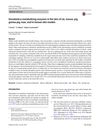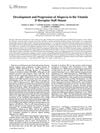TLDR Spermidine may improve skin health and hair growth by enhancing cell function.
This in vitro study explored the effects of spermidine (SPD) on human primary keratinocytes, revealing that 10 µM SPD increased cell viability by 9% and significantly altered 162 transcripts, enhancing pathways related to protein deubiquitination and cell cycle processes. Notably, the HR gene, important for hair follicle formation, was up-regulated, and pan-keratin protein content increased by 60%. Additionally, mitochondrial membrane potential improved by 84% with 1 µM SPD. These findings suggest SPD positively influences keratinocyte homeostasis and may enhance skin health and hair growth, although further research is needed to explore these effects under stress conditions.
74 citations
,
October 2023 in “Nature Reviews Molecular Cell Biology” 186 citations
,
December 2012 in “Current opinion in cell biology” Keratin proteins are increasingly recognized as important for cell health and are linked to many diseases.
 61 citations
,
July 2011 in “PLOS ONE”
61 citations
,
July 2011 in “PLOS ONE” Spermidine may help reduce hair loss and deserves further testing as a treatment.
126 citations
,
October 1998 in “Experimental Dermatology” The hr gene is crucial for skin and hair health, with mutations causing hair disorders.
42 citations
,
February 1996 in “Journal of Investigative Dermatology” Polyamines, especially spermidine, are essential for hair growth.
 38 citations
,
June 2018 in “Archives of Toxicology”
38 citations
,
June 2018 in “Archives of Toxicology” Different species and human skin models vary in their skin enzyme activities, with pig skin and some models closely matching human skin, useful for safety assessments and understanding the skin's protective roles.
 81 citations
,
January 2006 in “Journal of cellular physiology”
81 citations
,
January 2006 in “Journal of cellular physiology” Mice without the vitamin D receptor gene lose hair due to disrupted hair follicle cycles.
10 citations
,
August 2013 in “Experimental Dermatology” Hairless protein and putrescine regulate each other, affecting hair growth and skin balance.
 61 citations
,
July 2011 in “PLOS ONE”
61 citations
,
July 2011 in “PLOS ONE” Spermidine may help reduce hair loss and deserves further testing as a treatment.
33 citations
,
March 1994 in “PubMed” High ODC and low K1 and K10 may indicate early skin tumors in mice.


